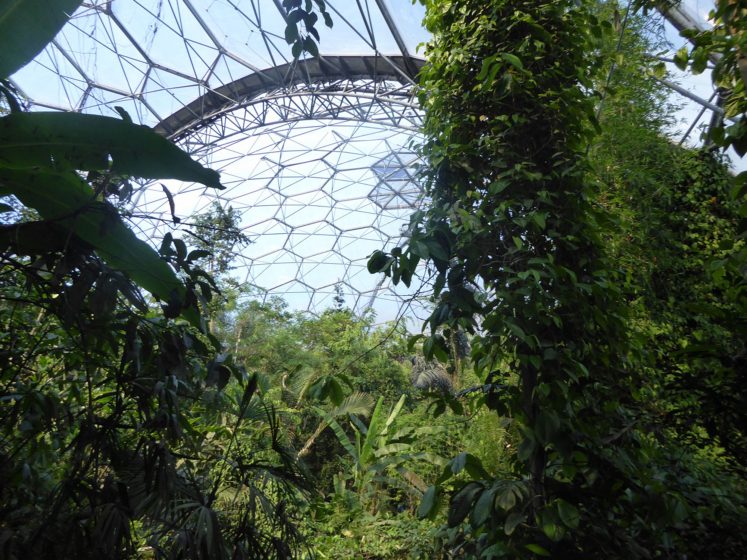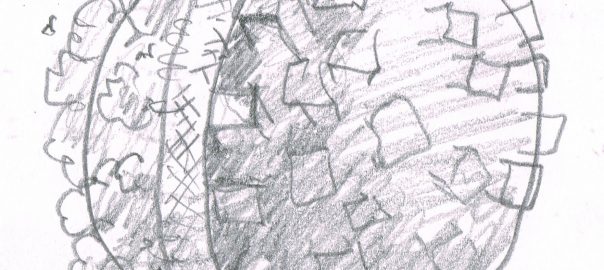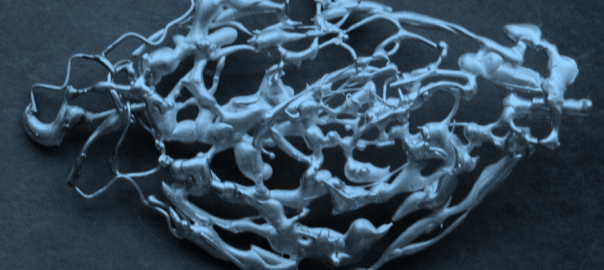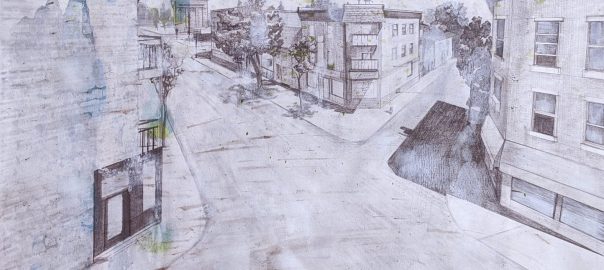If everyone on Earth lived like the average Melburnian or San Franciscan, we’d need the equivalent of nearly 8 planets. Seven of those planets don’t exist.
E. O. Wilson is a leading light amongst a coterie of scientists and conservationists “who have argued for years that setting aside at least half of the world’s land mass as off-limits to human enterprise is necessary if we are to conserve our planet’s biodiversity.” Wilson doesn’t seem to envisage fencing things off with a Berlin or Trump wall, and argues “that the process of setting aside half the Earth doesn’t mean moving people out, but being creative with park designations, restoration, and encouraging private-public partnerships.”

In this essay, I’m not going to reiterate all of Wilson’s arguments (his book is a good read and I exhort you to get hold of a copy), but I am going to accept his conclusion that in the interest of simple survival we can’t afford to use more than half the planet for human purposes. Just half.
From a nature of cities perspective, or at least from the point of view of non-human nature, the Half-Earth concept paints a rather wonderful picture of unspoiled wilderness and rampant, healthy, biodiversity. For those of us inclined that way, the biophilic quotient of the idea is staggeringly high. Assuming that such a goal was ultimately possible, and even before we look at how it might be possible, it is reasonable to ask what sort of cities could possibly fit such a vision. Although they are epicentres of human civilisation and culture and perpetrators of just about every environmental crime on the planet, Wilson doesn’t have anything to say directly about cities or urban systems in his book, so this essay is by way of a tentative exploration of the role of cities in achieving Half-Earth.
Unequal feet
The world’s urban areas take up only 3% of the Earth’s land surface—about 1.5 billion hectares—and half the world’s population lives in one third of that total urban area (see here). So if half the world’s population can live on just 1% of its land surface, what’s the problem?
The problem is that cities have two footprints, created by very unequal feet. The cities may only occupy 3% of the planet’s total land area but they have evolved and grown in areas of ecological productivity and occupy 12.5 percent of that area where they consume 75 percent of resources and produce 75 percent of all waste. One of the footprints is made by buildings and infrastructure that can be fairly easily measured in simple “plan view” (the 12.5% of ecologically productive area), and the other is the ecological footprint that Rees first described in 1992, expanded on and expounded in the pioneering book, Our Ecological Footprint: Reducing Human Impact on the Earth, which he co-authored with Wackernagel in 1996. “Ecological Footprints estimate the productive ecosystem area required, on a continuous basis, by any specified population to produce the renewable resources it consumes and to assimilate its (mostly carbon) wastes” (Moore & Rees 2013), and a city’s ecological footprint can be hundreds of times the size of a city’s physical footprint in plan. The area of London, for instance, is 157,200 hectares but its total ecological footprint is some 250 times greater at 39,500,000 gha (global hectares), an area larger than all the British Isles (31,515,900 hectares)(see here).
Biologically bound
Despite all of our pretenses and fantasies, we have always been and will remain a biological species tied to this particular biological world.
— Half-Earth: Our Planet’s Fight for Life, p. 211
That cities should be understood as not simply a collection of buildings and infrastructure but as an interdependent part of a larger regional entity is an idea that stretches back to the Ancient Greek concept of the “polis” and was fundamental to the thinking of Patrick Geddes, “founding father of town planning and environmentalism” (Kitchen 1975). Geddes inspired the work of that incomparable writer about cities, Lewis Mumford, who joined Geddes in his advocacy for a view of cities as entities intimately connected with the biological processes of their surrounding environs. Geddes “…recognized the important role of cities in the evolution of culture and maintained that a city has to be understood and integrated in the context of its biological and geographical region” (here).
A century after Geddes’ work this way of thinking about cities has yet to fully enter the mainstream, although change is afoot. Ultimately, the hinterland of cities needs to be regarded as part of their cities’ responsibility as de facto planetary resource managers. The framing of our thinking about cities has to see them in the larger context of city-regions or region-cities but as the Ecological Footprint model makes clear, the hinterland of a city can no longer be regarded as a garland of biology and resources that somehow fits neatly around its built form, but is instead more like globally distributed patches of resources, materials, water and energy connected to the city’s more familar physical form by both obvious and tenuous tentacles of road, rail, flightpaths and electronic communication.

Roads and buildings
There are approximately 200,000,000 hectares of road surface (paved and unpaved) on the planet. The problem with roads isn’t just the area covered by their surface, but their facilitation of intrusion into ecosystems. Driving 100 kms of 10 metre wide road through a rainforest doesn’t just result in damage from clearing vegetation for the roadway, its impacts are far wider, and the collateral damage from edge effects can spread into the adjacent environment much further than the width of the roadway. Road building and associated clearance in the Amazon provides a classic example.
Every building changes the condition of the place in which it is situated. Buildings modify the climate at a very local level. It’s the reason we build in the first place. Although there are innumerable buildings that don’t work very well or even exacerbate local conditions, buildings are fundamentally about creating shelter. This is why we manipulate material and resources to provide protection from the rain, channel cooling breezes, make shade, trap the warmth of the sun, and keep out the cold or the heat. The built environment can be configured to contain nature too. There are buildings that can produce conditions favourable to non-humans (albeit for human purposes) like the dovecotes that provide a home for pigeons and greenhouses that enable tomato plants to grow in cold weather. The use of glasshouses to create favourable conditions for certain kinds of vegetation and (to a lesser extent) fauna, has a history as long as that of the glass industry and 27 years ago found a kind of apogee in the shape of Biosphere 2, which was conceived as a prototype for constructing an entirely closed complex environment—an ecosystem in a very big bottle.
Advances in materials and technologies have continued to extend the scope of the humble greenhouse to embrace the concept of what might be called “pocket biospheres” across the globe, the most famous example of which is The Eden Project, constructed in a disused clay mining pit in Cornwall, England. The ambition behind these structures is often laudable, with lofty goals. The Eden Project is an educational charity that “connects us with each other and the living world” and proudly boasts that it houses “the largest rainforest in captivity”. It has spawned or inspired similarly ambitious projects such as The World’s Largest Oasis in Oman, where “A collaboration of engineering and architectural expertise has resulted in a botanic garden design that will become the world’s largest eco-park and serve to conserve hundreds of endangered botanic species”.
All of which is wonderful and positive and somehow encouraging, but as E.O. Wilson says:
The surviving wildlands of the world are not art museums. They are not gardens to be arranged and tended for our delectation. They are not recreation centers or reservoirs of natural resources or sanatoriums or undeveloped sites of business opportunities—of any kind.
He reminds us that the wildlands stabilize the global environment which supports our existence and that “We are their stewards, not their owners”.
Terraforming, and the trajectory of evolution
Let’s not be shy about this. We are unabashed planet-shapers—terraformers—and what we do affects the trajectory of evolution but, as Wilson puts it: “There is greatness in understanding the basic elements of human evolution and wisely acting upon the way they are linked”. In Half-Earth he writes optimistically that: “the biosphere gave rise to the human mind, the evolved mind gave rise to culture, and culture will find the way to save the biosphere”(p.50).
This echoes Vladimir Vernadsky’s proposition that “Just as the emergence of life fundamentally transformed the geosphere, the emergence of human cognition fundamentally transforms the biosphere”. This third phase of the Earth’s development (the other two being its geosphere and biosphere) he called the “noosphere”: the sphere of human thought. An atheist, Vernadsky shared the earliest use of the term noosphere with the radical Roman Catholic priest Tailhard de Chardin, who popularised the concept of the noosphere but related it to theology and his conviction that evolution was leading through complexity and consciousness to an ultimate “Omega Point”.
De Chardin’s ideas exerted a powerful influence on architect Paolo Soleri who interpreted complexity as key to the making of “arcologies”extraordinarily compact cities intended to maximise the growth of human consciousness and cultural endeavour whilst minimising the physical impact of the cities on the biosphere. His arcology designs provided the first detailed propositions for a kind of extreme urban solution that has had a formative influence on the development of the ecocity idea, particularly in its insistence on compact built form, the exclusion of motor vehicles and trenchant criticisms of suburbanism. Contained within their clearly defined physical boundaries, Soleri’s arcologies were designed to have (at least notionally) a minimal impact on wild nature and were conceived of as being instrumental in advancing human evolution towards the Omega Point. The idea that cities and evolutionary processes have some connection has a history dating back over a century when one of the finest and most influential sages in the realm of urban theory, Patrick Geddes, published his seminal work on Cities in Evolution in 1915.
Ecocities
Although ecocities have entered the lexicon and their influence on core ideas about what is loosely called ‘sustainable’ urbanism is undeniable, ecocity pioneer Richard Register (who became an advocate for what he came to call ecocities after being strongly influenced by Soleri) points out that their role as evolutionary agents has been almost completely neglected, that it rarely, if ever, surfaces in discussions about ecocity ideas and that evolutionary ideas are essentially absent from mainstream urban systems discourse (personal communication).
Evolution, it should be remembered, is not necessarily about upward and forward movement or progressive change. We can diminish ourselves and our world as readily as we might enhance it. It is potentially of great importance to understand that the making of cities is integral to whatever evolutionary process it is that humans are part of. The idea of Half-Earth is about understanding that humans have the power to influence the course of evolution and to make or break the ecological integrity of the planet in its presently evolved state. Failure to act on that understanding is to betray our species and diminish the potential for our collective future. The role of cities in evolution has to be embraced as a core concern in any proposal for achieving Half-Earth.
Reality and inhuman ethics
The reality of the world’s cities is so far removed from what the Half-Earth vision demands that it may simply seem preposterous to suggest that they could ever be changed sufficiently to fit on half a planet, but the picture of reality described by that vision demands that the operational values of human society and the cities that reflect those values simply must change if we are to have any hope of survival as a civilised species.
We now have some remarkable tools that might help us achieve the goal of Half-Earth Cities, including some that promise to do our thinking for us—but there are dangers in believing that we can’t solve our planet’s problems without relying on powerful advanced technology. Imagine, for instance, that we might create artificial intelligence that is charged with the task of protecting the biosphere from further degradation and returning it to ecological health. Given all the available information and a few basic algorithms to do with energy, resources, food, water and population, it wouldn’t take long for the AI to conclude that the planet would be better off without us. So if we want to stay a few steps ahead of our own cleverness, we need to work towards a healthy half planet that can support civilisation without relying on the technologies developed for the wealthy few (which depend upon a largely exploitative use of collective social and intellectual skills) but with the spirit and courage of the wise, and the wisdom that has also evolved, and continues to evolve from social exchange and shared experience.
Ecological footprint of the world’s cities

If everyone on Earth lived like the average Melburnian or San Franciscan we’d need the equivalent of nearly 8 planets just to maintain that level of consumption. Seven of those planets don’t exist. This slightly terrifying statistic is relatively well understood in the sustainable design community where the idea of One Planet Living (OPL)has significant traction. What is less well understood is that even though a full and genuine shift to OPL would be a radical and disruptive departure from business-as-usual, it would be nowhere near enough of a departure to ensure the long-term survival of civilisation.
The metric of the ecological footprint is based on data drawn from what has actually happened. It is, as my colleague Sharon Ede says, “looking in the rear view mirror”. Ecological footprint is about areas being used for productive purposes and does this well. This gives the EF substance and makes it a defensible and credible measure of resource use and its associated impacts but the metric does not include an area for the wild. To accommodate the Half-Earth scenario, OPL based on the EF metric needs to be recast as “Half-Planet Living”. The measure moves as the EF is based on a snapshot in time. As the population increases the amount of land available per person decreases. The world’s land area is 51 billion hectares. Writing in 2013, Moore & Rees observed that “There are only 11.9 billion hectares of productive ecosystem area on the planet. If this area were distributed equally among the 7 billion people on Earth today, each person would be allocated just 1.7 global hectares (gha) per capita. (A global hectare represents a hectare of global average biological productivity.)” ( p. 41 Jennie Moore and William E. Rees, Getting to One-Planet Living; Chapter 4 in State of the World 2013 Is Sustainability Still Possible? The Worldwatch Institute)
With the population now at 7.6 billion the area reduces to less than 1.57 gha per capita. UN mid-range estimates are that the world population is likely to reach 11.2 billion by the end of the century; that would result in an EF of little more than 1 gha per capita. Sharon Ede notes that the Global Footprint Network (who crunch the EF data) “deliberately choose conservative accounting methods (like not including a requirement for ecological space for other species) so they are not inflating the figures i.e., the Footprint is a huge underestimate of the impact we are having…” (email communication 20 April 2017). An assumption that we need to allow for a population of 12 billion would seem to be a reasonable basis for serious long-term planning, so that’s essentially 1 gha per person.
But the EF metric hasn’t included the wild. The basis for long-term planning of resource distribution should reflect the wild and if we accept the work of EO Wilson et al, then that 1 gha per person must be reduced to 0.5 gha. That’s almost inconceivable, but the figures do not lie.
Within this extremely constricted framework the idea of creating cities as models of miniaturisation, complexity and density makes a lot of sense and almost the only concepts developed in the modern era that address that challenge are those generated by Soleri and those extremely few people who have followed in his footsteps. If the noosphere is a real thing and if further densification and complexification are essential to human progress, then the goal of developing Half-Earth Cities becomes both a means of survival and a way to advance the evolution of our very curious species.
One gigahectare each
How do we fit cities into this? If we work with the 1 gha per person, to keep it simple, then the entire city plus the region with which it is interdependent must be planned on the basis of that figure—half of which needs to be wild. To use a very rule-of-thumb basis, a city of 1 million can only occupy 500,000 hectares for all its needs and at the same time be responsible for ensuring the continued existence of 500,000 hectares of wild land. Now, at least, we can see our way to a conceptual model for what a Half-Earth City needs to do and how much physical space it can occupy in order to obtain all of its resources and food within planetary limits. More than their cities’ purely physical dimensions, the ecological footprints of cities have to be massively reduced to fit the productive capacity of the planet and make it possible to sustain half the world in a wild state. For instance, if Melbourne’s EF is currently around 8 gha, then for it to become a Half-Earth city it would need to cut its EF to one-sixteenth, or barely 6 percent of what it is now.
This gives us a design goal. This means we can start working on this massive challenge right now. It will take decades to achieve something as confronting and enormous as Half-Earth Living but at least we can get started. It is through our cities that we act on the world, it is there that we realise the potential to shrink our footprints and manage the protection of wilderness. And, done right, the design of our urban systems can mesh with the work of Half-Earth scientists who are already designing ways to achieve an ecological safety net for the planet.
Paul Downton
Melbourne







Leave a Reply